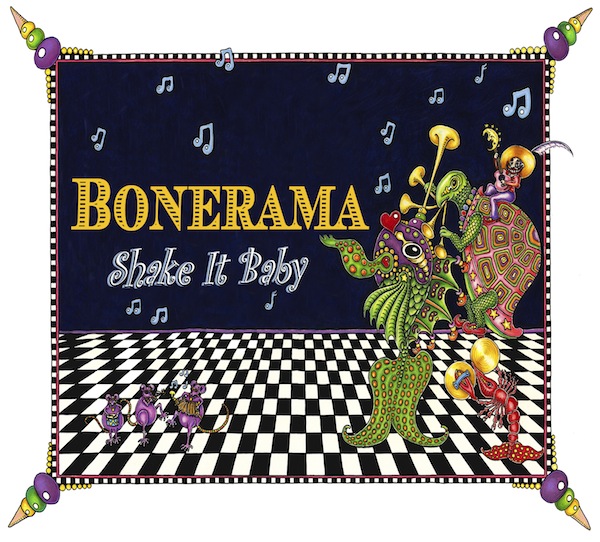
In the 1962 movie Kid Galahad, Elvis Presley belted it out like so.
“A poor man wants the oyster, a rich man wants the pearl, but the man who can sing when he hasn’t got a thing is king of the whole wide world…”
On January 16—at a South Baltimore venue called GAME on Warner Street—there will a bit of singing accompanied by a plenitude of brass and bi-valves during a show by the New Orleans combos Bonerama and Panorama Jazz.

Nick Schauman of The Local Oyster in Mount Vernon will cater the gig with more than a thousand St. Mary’s County oysters both raw and grilled from the True Chesapeake farm on St. Jerome Creek.
“They harvest to order,” said Schauman, 43, munching an apple while shucking a half-dozen Malpeque’s [from Prince Edward Island] for a customer’s breakfast.
“For a long time, oysters had become a special treat,” said Schauman. “You’d have to go to a fancy bar and eat them with a tiny silver fork. So I started shucking them on the street and taking them to music festivals. Once the line starts at the oyster tent, the party is on.”
The Deep South will also be represented at the festival with ribs and other grilled meats from Big Bad Wolf’s House of Barbecue—the cool shack on Harford Road made of yellow brick—in Hamilton.
Take it from another local—Nawlins, not Crabtown—raw oysters and the dirty funk of New Orleans brass bands might need to be experienced a few times before the beauty and brine hit the spot.
“They’re both an acquired taste,” said Charley Allen, a Los Angeles drug and alcohol counselor who grew up in Buras, a Louisiana fishing village near the mouth of the Mississippi. “The first time can be quite a shock, but if you relax, both of them will get your blood flowing.”
How does an oyster man wind up selling his wares in the shadow of Ravens Stadium while a six-piece Crescent City combo called Bonerama blows the bottom out of Edgar Winter’s “Frankenstein”?
The way R&B legend Rufus Thomas [1917–to–2001] taught the world—by walking the dog.
“About two years ago I was still doing landscaping and odd jobs,” said Schauman. “I was walking a client’s German Shepherd and met one of the neighbors. I told him I had started doing oysters and I guess he remembered me.”
The neighbor was David Shulman, a physical therapist who specializes in treating musicians, noting that six hours on stage can be as rough on a body as half that time playing ball. Schulman is the promoter of the January 16 event, billed as the “First Annual New Orleans North Jazz Festival.”
Schulman has a lot riding on the event, the success of which determines if a second annual comes to pass. He believes that the $30 ticket price and Schulman’s price of $18 for a dozen raw oysters in a cost-conscious town like Baltimore to be fair.
Minus great and organic music rooted in the very soul of the nation, the city on the Patapsco has much in common with the one where the Mississippi dumps into the Gulf of Mexico: a plethora of eccentrics and cheap bars to keep them inspired, a rich history of Catholicism, an inordinate amount of crime (much of it heinous) and, grandly, local seafood.
The distinction between a New Orleans oyster and its Maryland cousin, not counting in which waters they originated?
It’s the difference between Tabasco and Old Bay.
In addition to raw oysters, Schauman will be serving the delicacy grilled.
“You put’em on the grill on the half-shell, cup-side up and fill the shell with butter and parmesan cheese, that’s the New Orleans way,” said Schauman, noting the way it’s done at Drago’s in Metairie, one of Charley Allen’s oyster haunts when he’s back in the Pelican State.
In Baltimore it’s just the same, except for a sprinkling of Old Bay atop the cheese, which is the way Schauman did it for native Cajun Ed Reed when the former Ravens defensive star was inducted into the team Hall of Fame.
“Ed likes’em grilled,” said Schauman, who worked on the crew of The Wire during season three and cherishes the day Method Man taught him to juggle.
The “grillers” will cost a bit more than the raw on January 16—$2.50 each. Schauman is also thinking of boiling up some crawfish for the occasion, which will end with members of both bands on stage together.
But raw—not battered, not fried, not dipped in this and that—is the way the Lord of Salty Waters intended the oyster to be eaten.
“You can taste the difference in each oyster from where it comes from,” said Schauman. “Wine experts say they can taste the dirt from where the grape was grown. Oysters are distinct like that. If you don’t adorn them and you know what you’re looking for, you can tell by the waters they grew in.” ![]()


